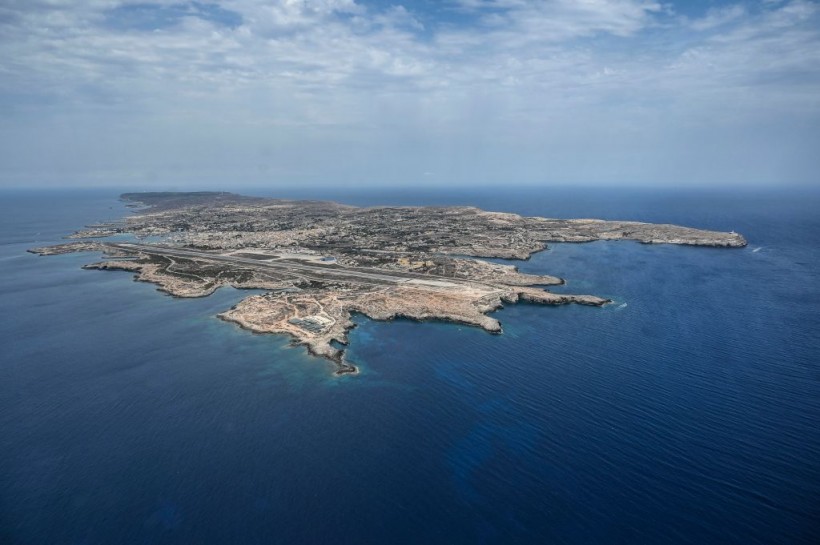
(Photo : Photo by Fabrizio Villa/Getty Images)
LAMPEDUSA, ITALY - AUGUST 04: Aerial view of the island of Lampedusa on August 04, 2020 in Lampedusa, Italy. The Italian island has reportedly run out of room to quarantine migrants, as is required as part of Italy's anti-coronavirus measures.
Over 1,000 migrants arrived on the Italian island of Lampedusa on Sunday, while an NGO warned that hundreds more were stranded in the waters off Malta.
The arrivals prompted calls for immediate action from far-right lawmakers amid new tensions between Italian authorities and rescue boats operating in the central Mediterranean.
According to BBC News, nearly 400 people of various nationalities were on board a single boat intercepted off the coast of Lampedusa, including 24 women and six children. Another boat transported 325 sailors, and hundreds more arrived on smaller vessels.
Matteo Salvini, the leader of the far-right League party, denounced the arrivals, according to a report by Alarabiya News. Salvini is on trial in Sicily for refusing to allow migrants to disembark when he was interior minister in August 2019. He demanded a meeting with Prime Minister Mario Draghi, saying, "With millions of Italians in difficulty, we cannot think of thousands of illegal immigrants,"
Meanwhile, Alarm Phone, a rescue organization, has requested assistance in locating three boats in Maltese waters, claiming that one rescue operation could save a total of about 231 people from drowning.
According to the International Organization for Migration (IOM), more than half a million people have arrived on Italian shores since early 2015. The waterway connecting Sicily and North Africa is also one of the world's most dangerous migration routes.
According to the IOM, 8,604 people arrived in Italy and another 65 in Malta between January 1 and April 21 of this year, with 359 deaths. Several NGO ships are stationed in the city, attempting to rescue those who have become stranded in the water after crossing in overcrowded or leaky vessels. Some protestors accuse authorities of allowing people to drown.
On the other hand, the NGOs have been accused of working with Libyan migrant smugglers to carry people to safety on European shores, which they categorically refute.
According to Alarabiya News, Sicilian judicial authorities restored a detention order against the Sea-Watch 4 vessel, operated by Germany's Sea-Watch organization, kept in Palermo for six months until March of this year.
Read Also: Illegal Immigrants to Be Sent $4.38 Billion Stimulus Checks
Immigration in Italy by the Numbers
In recent years, illegal immigration to Italy has decreased. In 2019, 11.5 thousand migrants arrived in Italy by sea, compared to 181,000 in 2016, according to a report by Reuters. In 2020, however, there will be a considerable rise in the number of immigrants arriving by sea on Italian shores.
Despite the overall decrease, anti-immigrant parties in Italy continue to campaign for tighter border controls, more deportations of migrants already in the country, and reforms to asylum laws.
Even though Salvini's attempt to put his League party to power in August 2019 failed, his anti-immigrant agenda continues to gain ground in regional elections.
One example is the League-backed election of Donatella Tesei in Umbria in October 2019. More recently, in Emilia-Romagna, the League came dangerously close to deposing a seven-decade-old center-left regional government.
Even though the center-left gained a majority, the League is just two percentage points behind the center-left as votes are distributed across parties.
Out of more than 2.2 million votes cast, the League nominee was defeated by around 100,000 votes. The key plan of their candidate's agenda was anti-immigrant policies.
Immigration in Times of COVID-19
In addition to domestic concerns, anti-immigrant groups profit from foreign events. Because of the COVID-19 outbreak, 60 million Italians have only recently been released from government-imposed quarantine, isolation, and travel bans.
The pandemic was centered around the northern economic hubs of Lombardy, Veneto, and Emilia-Romagna, with Italy having one of the highest case counts in Europe. The economic consequences for Italy have been severe and are still being felt.
Furthermore, Salvini and other anti-immigrant anti-EU politicians have used the pandemic to push for stronger border controls and blame the virus on refugees and foreign visitors.
Related Article: Stimulus Bill May Be Delayed Over Fury That Undocumented Immigrants Will Receive $1400 Checks








